CHIANG RAI
In the northernmost province of Thailand, on the borders of Laos and Myanmar, lies Chiang Rai, a smaller town of about 200,00 people that has one of the richest cultures and histories of the country. Renowned for its landscapes, with vivid green landscapes and dramatic setting on Mae Kok River, a tributary of the mighty Mekong, between the Daen Lao mountain range in the north and the Phi Pan Nam mountain range in the south, with views of the neighboring Shan State of Burma and Bokeo in Laos. There remains a great ethnic variety in the region, which has given birth to a unique culture formed by different clans knwn as hill tribes who retain their individual village structures.Chiang Rai offers the ultimate remote retreat for looking to escape, or family adventure in elephant camps, river and jungle exploration, and exotic hill tribe villages.
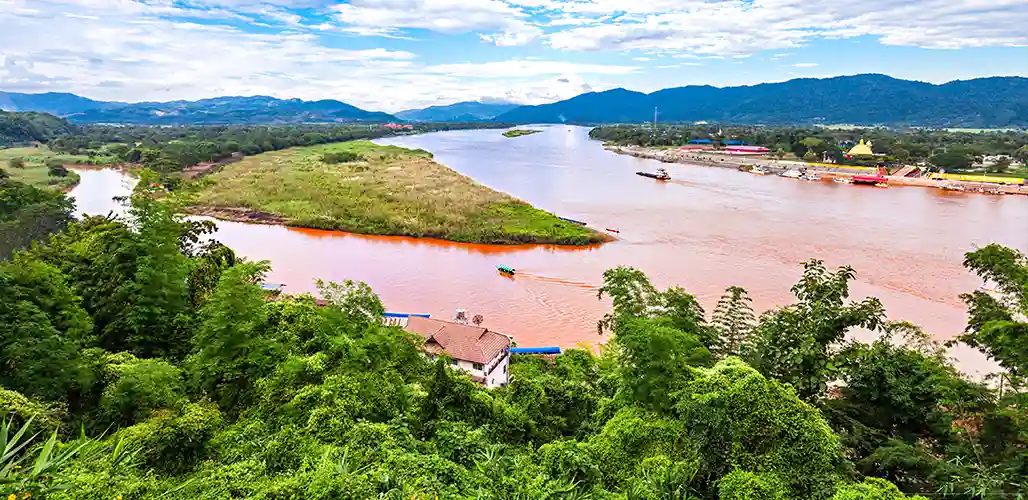
Chiang Rai has a distinctly northern feel, different to that of Chiang Mai and many times removed from the megalopolis sprawl and cacophony of Bangkok. Here is mall town charm where you can step back in time and soak up a quiet and humble culture. In what once was the center of the notorious Golden Triangle, explore the region’s dark past as the hub of opium production, immerse yourself in the ‘culture of the elephant’ (a national symbol that has for centuries served as the region’s workhorse), visit ancient temples and architectural landmarks (owing to Chiang Rai’s Lanna routes), and taste some of the most delicious food in Southeast Asia. Here are two world-class resorts, the Four Season's famous Tented Camp, perfect for a quiet, remote, and relaxing respite, and the Anantara, a resort long renowned for its elephant conservation program and enjoyable activities with elephants, including its mahout program. Both resorts provide a pleasant base for exploring the Golden Triangle.
Why come? We recommend Chiang Rai in conjunction with Chiang Mai, which is a picturesque half-day drive with numerous interesting stops and activities (including hiking, elephant camps, and mountain biking). From Chiang Rai, there is also a two-day cruise along the Mekong to Luang Prabang, our favorite small town in all of Asia, overnighting halfway.
Chiang Rai Highlights
- Majestic temples: Wat Phra Keow, Wat Phra Sing, and Wat Phra That Doi Thung, and iconic Wat Rong Khun - the White Temple
- Anantara Resort Elephant sanctuary—A perfect place to enjoy remote Thailand and elephants
- Night Market and local Thai pottery at Doi Din Dang Pottery
- Four Season's Tented Camp. The original ultimate escapist fantasy realized, set within a remote, jungle area of the Golden Triangle
- Mae Kok River, a scenic 80-mile long waterway runs through the heart of Chiang Rai, passing through many hill tribe settlements
- Learn about the regions infamous history as the center of the opium-producing Golden Triangle
- Departure point for scenic half-day driver through the mountains to Chiang Mai
Chiang Rai History
The northernmost province in Thailand, Chiang Rai, has one of the richest cultures and histories of the entire country. Neighbored by the Shan State of Burma and Bokeo in Laos, there remains a great ethnic variety in the region, which has given birth to a unique culture formed by different clans who retain their individual village structures. Chiang Rai, is also where Thailand, Laos and Myanmar converge on the Mekong River into the "Golden Triangle" notoriously known in years past for being the global center for opium production, but has since been superseded by Afghanistan as the world supplier of the drug. Over the centuries, Chiang Saen has witnessed numerous battles with the neighboring Burmese and gang wars among the drug barons of the infamous Golden Triangle. Owing to the government's vigorous opium eradication policies, however, the gangsters were obliged to depart, and an era of peace and legitimate prosperity dawned.
![]()
LUXURY HOTELS IN CHIANG RAI
Four Seasons Tented Camp
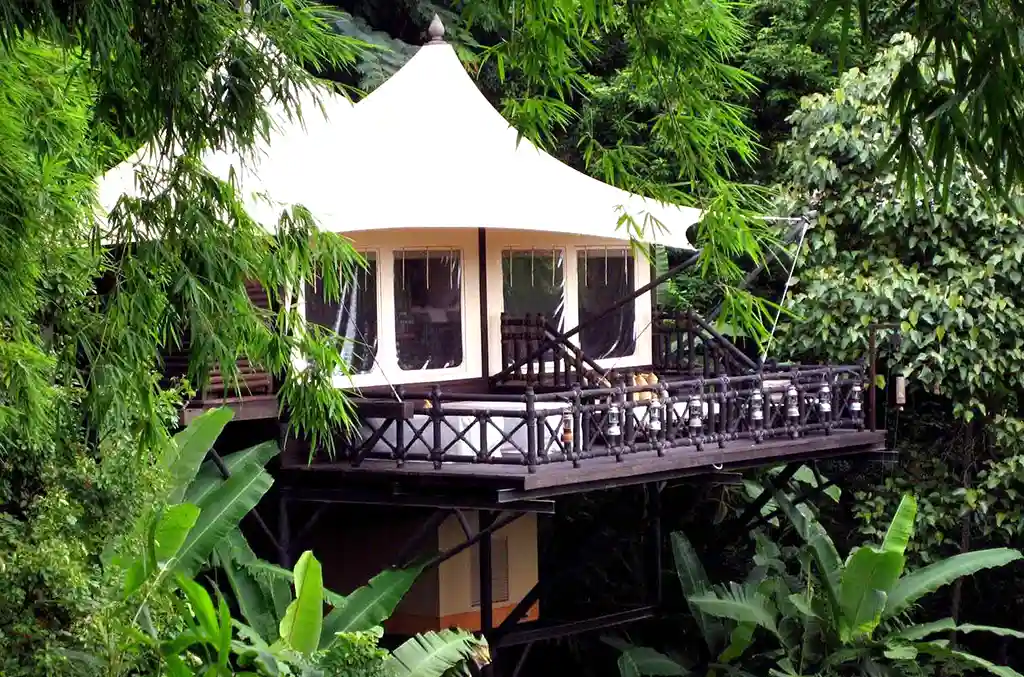
An hour and half north of Chiang Rai and world's away from the cacophony of Bangkok, the world-famous tented Camp is situated in the remote mountains and furthest reaches of the Golden Triangle. The sublime "jungle camp" is set on a lush hillside with views through the jungle off into Myanmar and Laos.
With only just over a dozen luxurious "tented" rooms, the tented camp is one of the most exclusive retreats in Asia, featuring hand crafted teak furniture and floors with safari chic amenities such as two-person hand-hammered copper bathtubs, leather-and-hardwood bush chairs, paddle fans and hardwood desk. Tented rooms are air-conditioned with indoor and outdoor rain showers, spacious deck area, and travelers will experience the warm and attentive service the Four Seasons and Thais are known for.
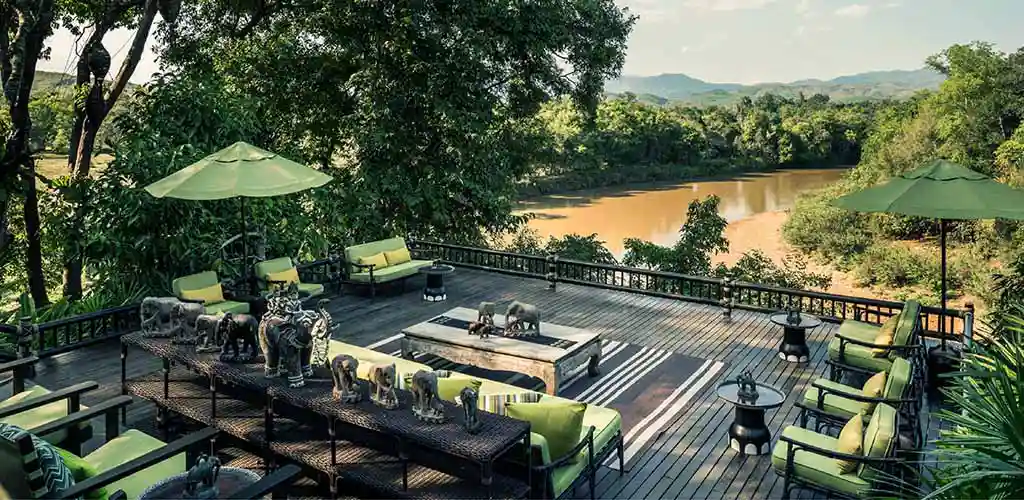
The camp also has free-form pool, whirlpool, spa pavilion, and dining venues, including a panoramic treetop bar and wine cellar, serving Thai, Laotian, Burmese, and Western favorites. Private meals can be arranged, including a picnic in the jungles further afield, candlelight dinner with Thai music, dinner atop a neighboring peak, and a private sunrise breakfast with the elephants at the Camp Peak.
Resort experiences feature elephant trekking (learning to bathe, feed and drive an elephant, before climb aboard for a ride through the jungle), Mekong River excursions, journeying on a riverboat to meet local hill tribes, and a new herbal adventure in which the camp chef and a botanical expert take you foraging into the Camp's natural surroundings, where you'll learn about-and gather-a variety of plants used for local cuisine and traditional medicine.
Three-Night Adventure Packages for one or two, all meals, open bar, camp activities and airport transfers included. Other packages available in conjunction with Four Seasons Chiang Mai. Note: Children under 10 years not permitted.
Our take: A sublime jungle escape for those looking for solitude and pure relaxation, this is not the place for active couples nor those interested in local culture. For shorter trips, consider either the islands or this jungle oasis for your down time, but not both. If you are looking for more for a combination of resort with local culture, we have better recommendations where to spend your time. Let us plan an overland drive from Chang Mai, a scenic four-hour journey through the mountain valleys of the north, pausing at temples and villages along the way.
Anantara Golden Triangle Elephant Camp & Resort
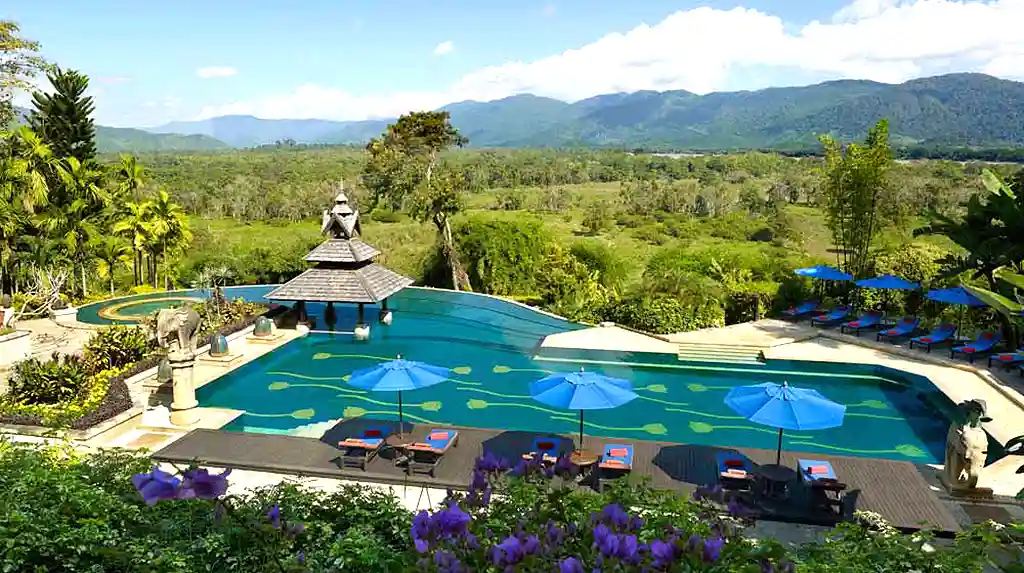
A mountain sanctuary perched on a hillside in the heart of the Golden Triangle with sweeping views of Thailand, Laos and Myanmar. This Anantara features tradtional Lanna-kingdom inspired architecture, delicious northern Thai cuisine, world-class spa and an elephany camp along the river with a population of mahouts (trainers) and elephants where guests may learn all about Asian elephants along with up close encounters.
Within over a 150 acres of tranquil, lush hills and grasslands, the resort is siutated at the confluence of the Mekong and Ruak rivers where Thailand, Laos and Myanmar join together. The local town of Sop Ruak is minutes away. Other local higlights include the fascinating Hall of Opium, a museum which covers the infamous history of the opium trade in the Golden Triangle during the 1970s & 1980s.
Lanna kingdom art and design a featured in the Anantara's décor and architecture, including wooden vaulted ceilings, rich teak flooring, golden sculptures, and Golden Triangle hilltribe textiles. Public spaces are spacious and include a large infinity pool with views of the surrounding valley and forests.
The resort's partner, the Golden Triangle Asian Elephant Foundation, is home to over two dozen endangered elephants cared for by villagers next to the resort. Enjoy a Walking with Giants excursion, accompanying the elephants on a causal trek alonng the river as they eat and are bathed. Learn from onsite experts about the elephants, including behavior, care, and conservation efforts.
At the three-storey spa, treatments include Yam Khang Therapy, in which the masseuse warms her feet on a heated ploughshare before using them to knead tired muscles. Yoga and muay thai kickboxing training are available. The ample staff caters to guest needs and requests in an attentive yet relaxed fashion.
The resort has 61 rooms and suites that have undergone extensive renovation recently, and are decorated with hardwood panelling, local fabrics and northern Thai art. Every room and suite features a veranda with views over the landscapes. Bathrooms include a deep terrazzo tub with a partition that slides open to take in the view.

Anantara Golden Triangle Elephant Camp & Resort offers the best dining in the area with authentic northern Thai dishes including kid's favorite, green chicken curry with young coconut shoots and wild betel leaves. A more elegant and intimate Baan Dhalia venue serves creative Mediterranean and Italian cuisine paired with wines from a well-stocked cellar. White truffles foraged around Chiang Mai are a unique house specialty.Drinks and lighter fare, from pad thai to burgers, are available all-day from the Elephant Bar and Opium Terrace. The morning buffet in Sala Mae Nam encompasses a varied selection of well-prepared Asian and international dishes as well as fresh fruits and juice.
Our take: The Golden Triangle's only large resort, terrific for families with an adjacent elephant camp and adventures along the river, mountains, villages, and forests. A pleasant alterantive to the busy islands in the south.
![]()
Chiang Rai Things To Do & See
Elephants! The big-eared gentle giants are everywhere in the Golden Triangle: you can hear their trumpets in the morning, they appear throughout as design motifs, and they even grace the labels of Chang Beer, which is served in the bar. Learning to “drive” an elephant is a highlight of visiting Chiang Rai and enjoying their playful antics during river bath time. Trekking through native forest and past picturesque rice paddies you can discover a rare glimpse of traditional mahout life.
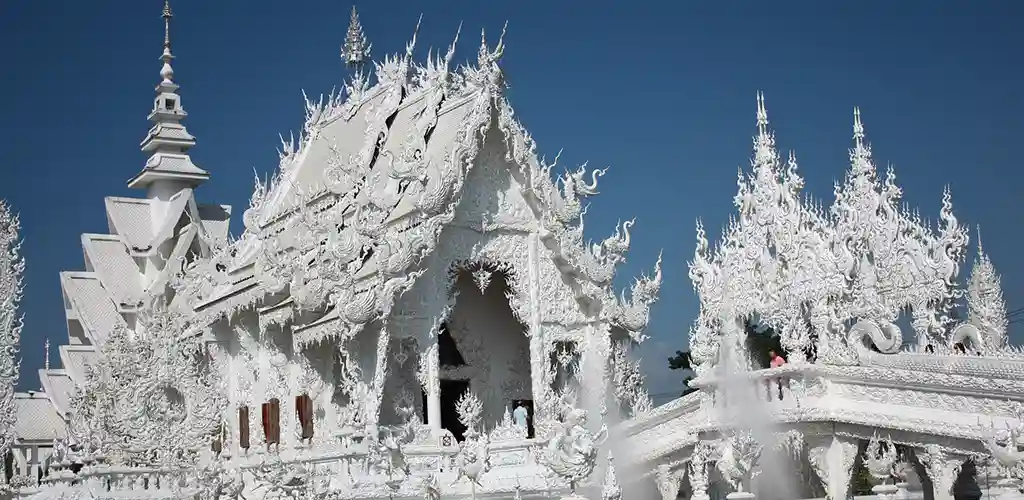
The White Temple
Chiang Rai is home to the extraordinary White Temple, built by the eccentric architect and artist Chalermchai Kositpipat, who who has vowed to make it his life’s work and continues to add wild structures and modernistic ornaments to the temple/art project complex.
Cycling the Golden Triangle
Cycling. In the early 90s we organized the first cycling tours in the region through our adventure wing, VeloAsia. Although Thailand has developed dramatically in the last two decades, there are still pleasant places for half and full-day biking tours we can fit into your trip, such as the beautiful landscapes and small hill tribe villages accessible only by boat and bike.
Mae Fah Luang Art and Cultural Park: Five kilometers from Chiang Rai’s center, this park/museum was founded by the late Princess Mother, who purchased the 140 rai plot to help assist youngsters from rural areas.
Before we head off into the mountains to visit one of the tribes, a trip to the Hilltribe Museum & Education Center will help you to understand their histories and how these ancient people live in modern times. and the work the center does on their behalf.
Chiang Sean: The northern part of Chiang Rai was the ancient Lanna capital, and today stands as a historical park, complete with awe-inspiring ancient monuments in the region’s signature rust-colored stone.
Doi Tung: Rising 2,000 meters above sea level, this revered mountain is home to several historical sites, including Doi Tung Palace, Mae Fa Lung Flower Garden and the Wat Phra Doi Tung Holy Relic.
Wat Rong Khun: Known as the ‘White Temple’, this remarkable structure is the life-time’s work of living artist Chaloemchai Khositphiphat, who continues to add to his Opus even today. The ornate white structure contains the glorious ordination hall, Phra Ubosot, which glitters with silver shards of mirror.
Wat Phra Kaeo: The ‘Emerald Buddha’, Thailand’s most revered Buddha image, was once housed in this wonderful temple.
Hall of Opium and Golden Triangle Park:
The massive 10-million-dollar Hall of Opium opened in 2005 after 10 years of planning. Visitors to the 5,600 sq.m. state-of-the-art exhibition will journey through more than 5,000 years history of the use and abuse of opiates. They will learn about the origins of the opium poppy, the medical and ritual use of opium in ancient civilizations, its spread throughout the world, the Opium Wars and their impact on China, the century of legal opium use in Thailand, the role of opium and other narcotics in modern medicine, and international efforts to control narcotics. Vivid and thought provoking presentations of the effects of drug abuse and case studies help visitors to understand the severity of addiction and choices available to fight the temptation of drugs.
A visit to the center dispels at once all suspicion of glorification of a trade estimated to be worth about 400 billion dollars a year as recently as 2000. Other displays allow one to glimpse life on a British clipper ship, racing through the seas laden with opium grown in India to barter for tea grown in China; the opium wars fought between the UK and China in the 19th century; secrets of smugglers, gambling possible death sentences against enormous profits; and the famous British Hong Kong finance houses based on the trade. One emerges into the light and can’t help but be saddened by the massive loss and misery to poor and humble, and rich and famous alike. The Hall is closed on Mondays. The nearby fields are now closed to poppies, now yielding tea, coffee, and macadamia nuts. Long may it be so.
Family Activities
The Anantara's elephant camp is the finest in Asia, offering a full menu of activities and experiences. The resort itself is surrounded by elephants who saunter through all day long, much to the delight of children.

Artists and other Introductions in Chiang Rai
Most attention on the art scenes of Thailand reference the capital of Bangkok, or the northern province of Chiang Mai. Less is known about the latter’s neighboring province, Chiang Rai, even though it is home to numerous artist studios, and is the residence of two of Thailand’s most renowned neo-traditional masters, Tawan Duchanee and Chalermchai Kositpipat.
ANGKRIT GALLERY Founded by Singapore Biennial co-curator Angkrit Ajchariyasophon, Angkrit Gallery is Chiang Rai’s only venue that consistently has contemporary art programming. The gallery is part of a building complex, where Angkrit runs a soup restaurant, a café and an artist residency space. Here, regular programs like artist talks and film screenings are also organized. In Chiang Rai society, where art appreciation is usually based on craftsmanship or religious art, spaces like Angkrit Gallery provide a platform to explore alternative modes of art-making.
DOY DIN DANG Doy Din Dang Pottery was established in 1991 by renowned artist Somluk Pantiboon (below). After establishing his practice as a master ceramist who has shown internationally, Somluk created Doy Din Dang as a way of promoting original ceramics for the home, as well as to provide training to villagers to develop pottery skills as a source of alternative income.
BAAN DAM Baan Dam, which means Black House, is the compound of Thai neo-traditional master Tawan Duchanee (below), comprising a permanent gallery of the artist’s works, and a gallery for both student and traveling exhibitions. The Black House is a popular tourist destination for Thai people who flock to own a piece of the artist’s creations from the merchandise store. Art plays a role in revitalizing the tourist economy with the initiatives of artists like Tawan, Somluk and Chalermchai.
WAT RONG KHUN Designed by neo-traditional master Chalermchai Kositpipat, the temple Wat Rong Khun also houses the artist’s museum. Hundreds of devotees and tourists flock to visit Chalermchai’s temple, in turn feeding the tourist economy of Chiang Rai. In Thailand, where art and religion are often intertwined, it is common to find artist-designed Buddhist amulets for sale.
ARTBRIDGE CHIANG RAI (ABCR)Art Bridge is Chiang Rai’s newest art space that has been built by the fundraising efforts of the local artistic community. Comprising exhibition, performance and café spaces, it will be run by the community to promote Thai arts as well as those of the Indo-Chinese region.
Somluk Pantiboon is an international artist whose award-winning ceramics are flavored by a great sense of the local. Born in Chiang Rai and trained in Chiang Mai, Somluk worked for five years on pottery and printing projects  at Khmer and Lao refugee camps before training with master ceramicists in Japan. His training in Japan allowed him to fully understand how a variety of influences and techniques may be absorbed and distilled. On settling in Chiang Rai, Somluk and his wife, Tamako, founded Doy Din Dang, a showcase and studio for his work. Nestled amidst idyllic scenery, Somluk and Tamako are ever-present to greet visitors, and their café adds to a certain ambiance. The simplicity of Somluk’s large and robust ceramic vessels belies a complexity of thought and references. Based on the form of seeds, the artist is concerned with cycles of growth and rebirth—ideas that can be generically linked to Buddhist thought—and Somluk has written about his concerns for the detrimental environmental effects of consumer culture. His ceramics ultimately emerge as objects of contemplation; their organic and tactile forms, with naturally uneven glazes, suggesting a means of thinking about our relationship to nature and the world we live in.
at Khmer and Lao refugee camps before training with master ceramicists in Japan. His training in Japan allowed him to fully understand how a variety of influences and techniques may be absorbed and distilled. On settling in Chiang Rai, Somluk and his wife, Tamako, founded Doy Din Dang, a showcase and studio for his work. Nestled amidst idyllic scenery, Somluk and Tamako are ever-present to greet visitors, and their café adds to a certain ambiance. The simplicity of Somluk’s large and robust ceramic vessels belies a complexity of thought and references. Based on the form of seeds, the artist is concerned with cycles of growth and rebirth—ideas that can be generically linked to Buddhist thought—and Somluk has written about his concerns for the detrimental environmental effects of consumer culture. His ceramics ultimately emerge as objects of contemplation; their organic and tactile forms, with naturally uneven glazes, suggesting a means of thinking about our relationship to nature and the world we live in.
Thawan Duchanee is one of Thailand’s most high-profile and revered artists and master of contemporary Asian art. Larger-than-life Thai artist Thawan Duchanee is one of the foremost representatives of Thai and Asian art. His penchant for traditional Asian motifs and styles and his flamboyant personality have earned him popularity and renown as one of the leading lights of the international art scene. Thawan Duchanee was born in the northern province of Chiang Rai in September, 1939. He began his artistic education at the Poh Chang Arts and Crafts College and then studied under the late Italian painter Corrado Feroci (Silpa Bhilasri) – known as the father of modern Thai art – at Silpakorn University. Thawan furthered his artistic education in Europe, gaining a deeper understanding of Western artistic traditions at the Royal Academy of Visual Arts in Amsterdam.
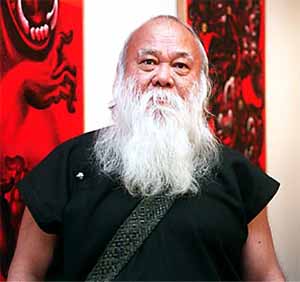 On his return to Thailand, Thawan developed a unique style of artistry using black and red tones, based on the styles of traditional Buddhist art to explore the darkness lurking within humanity. His pictures initially shocked many people as being blasphemous to the Buddhist religion and some of his early exhibitions were attacked. But many leading Thai intellectuals supported his work. Kukrit Pramoj for one claimed “his art is to be understood as giving life to myth.” Thawan’s art quickly gained prominence, in Thailand and internationally. He has exhibited extensively in Thailand and around the world, and has created murals at several overseas Thai embassies, public and commercial spaces including the Bank of Thailand, Shell Building, Bangkok Bank, Doi Tung Palace and Siam Commercial Bank among others. In 1998 Thawan designed a golden banner to mark the 6th cycle birthday anniversary celebrations of HM the King. He has represented Thailand and Asian art at top events around the world on numerous occasions. Thawan’s residence in Chiang Rai, known as the Black House, is also a museum and studio for art. He also set up the Thawan Duchanee Museum of Art at the UCOM Building in 2001.
On his return to Thailand, Thawan developed a unique style of artistry using black and red tones, based on the styles of traditional Buddhist art to explore the darkness lurking within humanity. His pictures initially shocked many people as being blasphemous to the Buddhist religion and some of his early exhibitions were attacked. But many leading Thai intellectuals supported his work. Kukrit Pramoj for one claimed “his art is to be understood as giving life to myth.” Thawan’s art quickly gained prominence, in Thailand and internationally. He has exhibited extensively in Thailand and around the world, and has created murals at several overseas Thai embassies, public and commercial spaces including the Bank of Thailand, Shell Building, Bangkok Bank, Doi Tung Palace and Siam Commercial Bank among others. In 1998 Thawan designed a golden banner to mark the 6th cycle birthday anniversary celebrations of HM the King. He has represented Thailand and Asian art at top events around the world on numerous occasions. Thawan’s residence in Chiang Rai, known as the Black House, is also a museum and studio for art. He also set up the Thawan Duchanee Museum of Art at the UCOM Building in 2001.
Chalermchai Kositpipat emerged in the late 1970s alongside Thawan Duchanee as one of the leaders of neo-traditional, Thai art. Neo-traditional art may be understood in terms of the use of allegory and figuration as these modes may pertain to Thai art, but in a manner that re-invents the form of historical representation.
Chalermchai has continued to explore his approach to a re-invention of traditional form with outstanding architecture in Chiang Rai city. At the heart of his work as an artist and designer is an understanding that Thai culture and Theravadan Buddhism require ever-new forms to communicate traditional meanings to ever-new audiences.
As the critic and curator Apinan Poshyananda pointed out in his book Modern Art in Thailand: Nineteenth and Twentieth Centuries, “Surface decoration, bright colors, and finicky detail are particularly characteristic of Chalermchai’s later works…”
Chalermchai draws our attention to details in order for us to appreciate the minutiae of the lessons that Thai Buddhism has to teach us. His work in painting and architecture draws crowds, and we are required to decipher the symbols and insights his art demands. Like all great artists, beauty is the key to our engagement.
![]()
Dining in Chiang Rai
Northern Thai ("Lanna") cusine is famed for its spicy kick with influences from Yunnan styles. Try some popular ones, including sai oua, a grilled spicy pork sausage which you can try at the night bazaar, and khao soi—made from soft egg noodles with mild, coconut-based curry with crispy egg noodles. Another street food stalls favorite, easy to find.
Local Restaurants
The Night Market food stalls offer a delicious variety of small plates, featuring northern cuisine. There is really no formal dining in small Chiang Rai (which you should consider your resort for). The best Western-style restaurant in town is Old Dutch, serving Thai and Western food, including steaks and salads, and several Indonesian dishes usually appear on the menu too. Thai dishes are tasty, but toned down for Western tastes, but if you like it spicy, just say, "ow phet." Service is efficient and attentive, and there's draught beer on tap as well.
The gorgeous river views alone at Lahn Tong are enough to make you want to visit, but there’s also excellent northern Thai food.
The North is a Thai-Norwegian ownership, which provides the hotel that this restaurant is in gives a distinct vibe. The mostly northern Thai food is exquisite and wherever possible the produce used is organic, sustainable and local. Afterwards, head to the Turntable Bar, where you can have a drink and listen to jazz records. Located near Sirikorn Market, which is also worth a glimpse.
Local cafés
The Coffee House or in Thai, Chivit Thamma Da. Nestled in lush greenery on the banks of the Mae Kok river, this quaint, colonial style country house is a surprise find amongst the banana plantations and busy roads buzzing with scooters. The cozy atmosphere in this home away from home is filled with exquisite Chintz covered furniture, memorabilia, and interesting books and boasts a huge wooden porch overlooking the enchanting riverside garden. A piano sits idle on the balcony while an old fashioned swing sits amongst trees. Enjoy a cappuccino in your china tea cup while playing with Cappuccino, the owner's dog.
Finer Dining in Chiang Rai
There is a derth of fine dining in Chiang Rai, a place known for its street food and casual spots. The two top choices for dining in a more refined environment we recommend are:
Jatujak Gallery & Restaurant
Delicious Thai in a a vintage art gallery setting. Downtown location, perfect for a stroll before or after dinner. Traditional local Thai with a modern twist.
Le Meridien
Chiang Rai's only luxury hotel within town offers International buffett, Italian, and Thai-style tapas.
Nightlife
In this remote outpost, the main night attraction is wandering the Night Market, which is a more toned-down version of the raucous Night Bazaar in Chiang Mai.
Readings & Media
For an insight into northern Thai village life and the culture shock experienced by a young Canadian volunteer, read Touch the Dragon: A Thai Journal, by Karen Connelly. Sightseeing by Rattawut Lapcharoensap is an illuminating, often funny series of short stories about everyday Thai life.
When to Visit (Chiang Rai Weather)
Although it can be chilly between November and February (layers are a must), Chiang Rai weather in general is similar to Chiang Mai, with warm weather year-round (with highs averaging in the 80s F°), though nighttime conditions during the dry season can be cool and are much lower than daytime highs (mid 50s F° in January). Rain falls from June through October (August is the rainiest month), with the rest of the year virtually dry, although even during rainy months there is sunshine almost daily averaging at least 5 hours a day even in August. Note: This area is the jungle, so light layers and insect repellent will protect you from bites and bring outdoor gear you don't treasure for muddy hiking, mountain biking, and elephant training.

